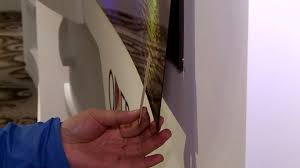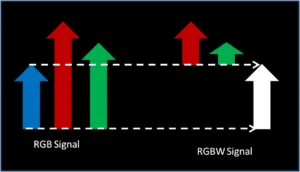LG Electronics is implementing a number of improvements and features in their 2017 OLED HDR TVs. To learn more, we initiated a conversation with Neil Robinson, Director of Technology Partnerships at LG Electronics in the US.
We started the conversation by asking about how LG will manage the darker tone levels in their OLED TVs. Current OLED TVs have sometimes crushed the blacks meaning details in the darkest levels are less visible and there is a big step from complete black to the first visible black level.
Robinson explained that this is almost inevitable because of panel variability. Like all display technologies, there is panel-to-panel variability due to manufacturing process tolerances. OLED is able to achieve absolute black, and because of this, most consumers would obviously find an elevated black level to be very objectionable. Factory tolerances therefore trend towards a zero black point. Factory calibration helps to compensate for these variations, but manufacturers must strike a balance between the cost of extended factory calibration, and the impact to the retail price of a product.
A more rigorous post install calibration can definitely enhance accuracy however, points out Robinson. For example, calibrators can use the “brightness” control to set the point at which the display renders black with respect to the input signal. “In 2017 models, we have given much finer control of the brightness, which makes a big difference. There are also 2-point and a 20-point gray scale adjustment options for all inputs allowing more flexibility in adjusting to fit the appropriate EOTF.”
 LG’s wallpaper TV
LG’s wallpaper TV
TV brands have other options with the OLED panels sourced from LG Display as well. These brands can choose to do more extensive factory calibration, for example, to get better control of the dark grey levels and EOTF tracking. This can be done with 1D or more sophisticated 3D LUTS, if they so choose. Dealers in the CEDIA channel have similar options.
LG’s 2017 models also support Dolby Vision and calibration for this content is done very differently, explained Robinson. In this case, a sensor is used to measure various parameters of the display using SpectraCal’s CalMan software. Calman then uses this data to generate a file which is stored on a USB stick and inserted into the TV where it is used by the Dolby Vision processor to create custom tone maps based on the actual performance of the individual TV instead of relying on generic specs. Robinson said LG plans to keep the profile on the USB stick, which must be in the TV when displaying Dolby Vision content instead of loading it into memory on the TV.
For 2018, Robinson says they are working on an automated calibration . This approach would feature an automated routine to take measurements using a sensor and software, directly controlling the relevant parameters in the TV to make any corrections necessary.
HDR tone mapping using a 1D LUT leads to hue shifts becuase you are changing the ratio of the red, green and blue components independently. A 3D LUT can be used to avoid these hue shifts, and while the LG TVs support this method, they have developed a hardware-based “hue correction” algorithm “We are not aware of anyone else using this approach,” noted Robinson. “It is actually based on a method developed and used in Hollywood.”
LG Working with Technicolor
Robinson also commented on the new partnership with Technicolor that was announced at CES 2017. 2017 LG Electronics HDR TVs will now have a “Technicolor” picture mode, which basically manages the proper display of SDR and HDR content. The mode is designed to ensure, with guidance from Technicolor, that each of these signals is properly processed for delivery to the display; there is also support for SDR-to-HDR conversion. The addition of Technicolor’s HDR distribution format brings the total number of HDR formats supported by LG TVs to Four: HDR10, HLG, Dolby Vision and Advanced HDR by Technicolor.
In addition, Technicolor plans to start to replace the aging Plasma monitors in its grading suites with OLED TVs supplied by LG Electronics. Using the TVs in this application is more challenging as they must be calibrated extremely accurately. LG has worked with Technicolor allowing them all kinds of customization and calibration of the hardware and software in the display. As this process is refined, LG hopes that the lessons learned through this collaboration can be rolled out into consumer models either with firmware updates or in future products.
In professional applications, the other issue is how to manage content highlights that exceed the luminance capabilities of the display. One approach is to have the monitor simply hard clip the value at the peak luminance of the display. In other words, if the display has a peak luminance of 540 cd/m², then any pixels above this get mapped to the 540 cd/m² level.
Another approach is to use tone mapping curves that map these higher luminance levels to the last 10% or so of luminance of the display. This method will preserve highlight detail, and give a good representation of how a consumer HDR TV would render content, but cannot be used as a grading reference, because downstream TVs have no way of knowing what tone mapping approach was used.
In addition, the static metadata that is being added to HDR10 content today is very inconsistent. It is so inconsistent that many manufacturers are now choosing alternative ways to tone map content. One way LG is addressing this is to use dynamic tone mapping. Here, the idea is to look at the average picture level of the frame or scene and select the tone mapping curve that works best for content in this range. For brighter or darker content, a different tone mapping curve might be chosen. This should provide more flexibility to create more pleasing pictures.
RGBW Explored
Robinson also touched on the subject of color volume, which is guaranteed to generate much industry discussion this year. Robinson started by reviewing that OLED HDR TVs use an RGBW pixel structure, but there is no sub-pixel rendering – every color pixel has an RGBW group of sub-pixels.
The way the white sub-pixel is used is to first look at the white component of the incoming signal pixel. All colors are a combination of red, green and blue – each at different brightness levels. But this can be looked at as the combination of minimum levels of RGB for that color (the white component), plus the extra values above that determine the final color. That means every color except very saturated colors, has a white component. This value is essentially subtracted from the original RGB value and delivered to the white sub-pixels with the balance of the signal delivered to the RGB subpixels (see figure). This approach makes the LG OLED displays much more efficient, while maintaining an accurate color volume.
The addition of a white sub-pixel also allows the possibility of increasing the peak luminance by increasing the amount of white. If this approach is used, the color volume will have an extended dome on the top, which is different from traditional RGB additive displays. Robinson was clear that LG is not trying to conceal this fact, but commenting that most light sources and specular highlights are neutral colors, and that it’s very important that human visual perception, particularly as it relates to HDR, be considered in how any color volume metric is used to characterize a display.
This and several other methods to measure and discuss the value of color volume will be a hot topic of discussion at the upcoming March meeting of the International Committee on Display Metrology (ICDM). – CC

